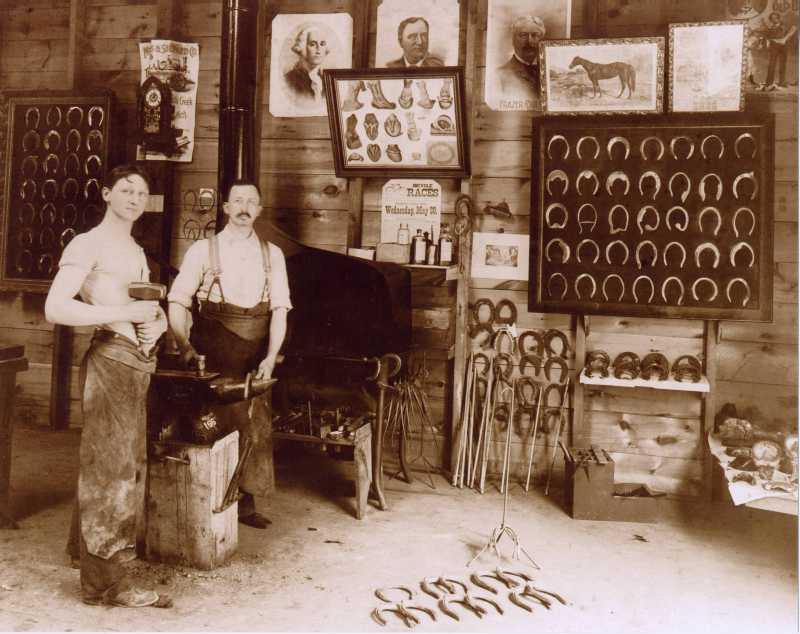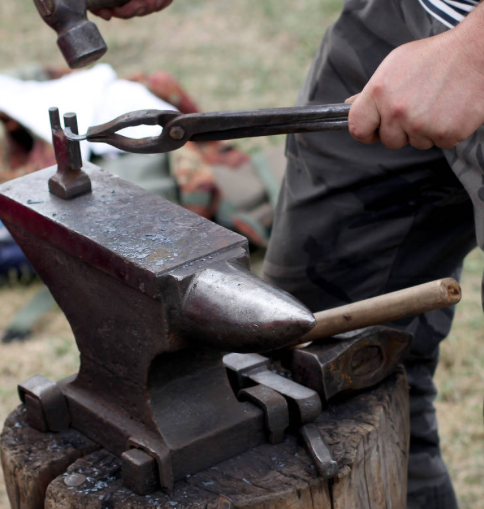
Somewhere between 5,000 and 10,000 people in the United States still practice the craft of blacksmithing. Of that number, however, only about 10% do it professionally.
These are the people who are keeping alive a craft that has centuries of rich and important history.
We've built our business on creating historical reproductions in the designs and style of our metalwork. Read on to learn more about the history of blacksmithing, old west blacksmith work, and where we found our inspiration for Old West Iron.

Blacksmith History: The Origins & Early Years
The first evidence of blacksmithing and iron working can be traced all the way back to 1500 B.C. The Hittites discovered how to forge and temper iron ore. When the Hittites were scattered, their knowledge of metalwork spread with them.
In these early years, many ancient cultures linked blacksmithing with supernatural superstitions. With greater technological developments at the start of the Iron Age, however, these mythical beliefs began to fade.
It was discovered that by reducing natural iron ore with heat, it was possible to produce wrought iron. This substance was perfect for making simple tools tougher than those made from stone.
These discoveries helped blacksmithing cement its place in world history.
Ancient understandings of iron were crude, and so many of the tools and weapons they produced were inconsistent. Some were too soft to a hold a sharp edge, and others were too brittle and broke. Although they had difficulties nailing down the best techniques for working with iron, they did discover two crucial developments in blacksmithing: charcoal and steel.
Early smiths found that charcoal produced a better fire. It burned hot and for longer periods of time. Because blacksmiths could more easily control these fires, they were able to produce more accurate work on more complex items.
Occasionally, these early forgers of blacksmith history would make steel. Steel is a combination of iron ore and carbon, which early smiths found in the charcoal they used to start their fires.
Steel weapons were quite powerful and often handed down through generations. Some were thought to have magical or spiritual powers, and they often carried an air of mysticism.

Blacksmithing History of the Middle Ages
The medieval period of world history is when blacksmiths began to become essential members of their small towns. Everyone had the "village smithy," and blacksmiths were revered for their technical understanding of steel.
Blacksmiths were respected because they created all manners of necessary goods: farming implements, household objects, weapons, armor. They were indispensible in making tools that other members of the village couldn't live without.
This is also the period when more blacksmiths began to specialize. "Whitesmiths" were craftsmen who worked with lead. The "blacksmith" was the ironworker. The "farrier" specialized in making and fitting horseshoes, and "chainsmiths" and "nailsmiths" specialized in the tools that gave them their names.
In the Middle Ages, the remaining air of mystery around the profession was often created by the blacksmiths themselves. They harshly guarded the secrets of their trade.
Trade guilds, run by the master blacksmiths, laid out rules and punishments for revealing anything to those who were not members of the guild. This wasn't their only purpose, though. Guilds also regulated materials as well as how many blacksmith apprentices were allowed.
The existence of the guild helps show how important blacksmiths were to society at this point in world history. This sort of regulation meant that there was a focus on formalizing the trade and preserving it.

The Old West Blacksmith
The image of the blacksmith in the Western town hammering away at horseshoes might be the first one that comes to mind when we think of blacksmiths. With the onset of the Industrial Revolution, there were major changes to the blacksmithing profession. The "village smithy" had to adapt to our familiar frontier blacksmith.
Much of the new machinery of the industrial era meant that mass production became possible. Blacksmiths were employed less often in the production of goods like weapons or nails, and they became more occupied with farrier work.
This was the time when people relied on the blacksmiths in their communities for their small, everyday essential items, like horseshoes. Despite the threat to their trade from the Industrial Revolution, the first half of the 1800s is considered the "golden age" of American blacksmithing. They were crucial members of the developing communities on the frontier.
Blacksmiths also turned to making and repairing wagons and carriages in the Old West. It was a trade that had not yet been swallowed by the Industrial Revolution, but it was more important than ever. People were moving from farms to cities, or traveling out West, and they needed reliable means of transport.
This shifting focus to equestrian products and carriage repair helped blacksmiths maintain a respected reputation. They were losing work in other fields, but they still had their prestige in the transportation industry.
Expertise as farriers found work for Old West blacksmiths with both the Union and Confederate armies during the U.S. Civil War. They were employed to shoe horses as well as repair wagons, horse tack, and artillery equipment. Armies put together a sort of traveling forge where these blacksmiths worked.
The Old West blacksmith was both a tradesman and a businessman, running his own workshop. They took on a number of different projects in addition to horseshoes and wagon repairs. These could include repairing farm tools, such as hoes, plows, and rakes. Sometimes blacksmiths even repaired kitchen utensils.
Unlike the medieval blacksmith, the Old West blacksmith stayed away from specialization. It was more important to their livelihood to be able to complete a variety of jobs. Frontier blacksmiths also did not have trade guilds.
Similar to their medieval predecessors, however, Old West blacksmiths depended on apprenticeships to learn and enter the trade. Master blacksmiths would take in younger people who wanted to learn the trade. These apprentices received room and board for assisting the master blacksmith and working alongside him. By the mid 19th-century, some apprentices earned a small wage.

Old West Iron: Metals & Tools of a Frontier Blacksmith
Before the mid 19th-century, many blacksmiths were still working with wrought iron. It was cheaper and easier to shape than some of the other metal options. But as demand for tools and equipment changed, steel became a more readily available and popular option.
Steel became the metal of choice for large farm tools. Blacksmiths still used wrought iron, however, for smaller, everyday projects and some repairs.
In many cases, blacksmiths collected scrap metal for projects. It could be expensive to always buy new metal, so they developed habits of reusing anything they might have had leftover from other jobs
While some tools for blacksmithing could vary depending on the smith or the workshop, there were some essentials every Old West blacksmith had. Every smith needed a forge, a bellows, and an anvil. These were crucial to properly heat and shape the products.
The forge was where the blacksmith heated the metal over a charcoal fire until it was hot enough to manipulate. The bellows allowed the smith to blow gusts of air into the fire, concentrating it and making the fire hotter. Anvils were where blacksmiths would do the final shaping of the project.
The common shape of the anvil as we think of it today is called the London Pattern. This design became standard in the 1800s. It evolved this way because every part of the anvil has a specific purpose.
The flat face of the anvil is for hammering. The holes on the anvil allow smiths to punch holes through their projects if needed. The horn, or the front part of the anvil, is curved so smiths can use it to shape metal.
Different jobs required different smaller tools. Some common ones included hammers, tongs, wedges, and chisels. Hammers and chisels help with shaping metal pieces, and tongs allow smiths to move pieces around in the fire.
Workshops were designed for practical purposes. The forge was in the workspace, and the anvil was always close by. Shoeing stands were also commonly seen in the workspaces of blacksmiths who worked as farriers.
Many workshops also contained a sort of waiting area. This space often contained a table or some chairs. Customers could sit comfortably while they watched a blacksmith complete their work.

The Modern Blacksmith
After the Industrial Revolution and the age of Old West iron, the role of the blacksmith shifted again. Some started doing architectural ironwork. Some transitioned into the first generation of automobile mechanics. Some focused on custom, intricate iron creations.
The Great Depression, however, halted much of blacksmith history.
These days, the revitalization of the blacksmith trade is less about necessity and more about artistry.
A Frenchman named Jean Tijou first introduced the art of decorative blacksmithing in the 17th century. This is similar to the resurging emphasis on craft and design in blacksmithing today.
Metal products, made from both traditional and modern techniques, are once again seen as a way to decorate a home. Iron door knockers, for example, can add an authentic edge to rustic decor.

Blacksmithing Techniques
Over the course of blacksmith history, smiths have developed a number of different techniques for shaping and working with metal. A number of them refer to the different ways that smiths bind metal together.
Forging is one of the blacksmith's primary techniques. This is what we think of when we picture a blacksmith working in his workshop: the smith first heating the metal, and then hammering it. Tools created by forging tend to be quite strong.
Drawing out is a certain type of forging in which the metal is hammered until it is longer or wider. This usually helps improve the quality and appearance of the iron. Upsetting is the opposite technique: a piece of metal is heated and then hammered to be smaller and thicker. This technique was often used for making rivets.
Welding is a method by which blacksmiths can join two pieces of metal together. They heat two pieces of iron until the surfaces are partially melted and then carefully fuse them together with a few hits from the hammer.
When done properly, a welding job is nearly invisible. Plus, the resulting piece of metal is just as strong as the original pieces of metal. This technique requires a certain amount of skill to attain just the right temperatures on the metal.
There were three heats necessary for the proper performance of blacksmithing that were described in an early treatise. The first was snowball heat, or white heat. There was also full-welding heat, and low or light-welding heat.
Snowball heat is the hottest and used to weld iron. Full-welding heat is not quite as hot and is used to weld mild steel. The last, light-welding heat, is the coolest of the three, and it's rarely used. It takes a lot of skill to use correctly.
Other binding techniques that blacksmiths use include riveting, collaring, pinning, screwing, and bolting. Collaring refers to wrapping a band of iron around two pieces to join them together. Screwing and bolting weren't used until the 19th century.

Old West Iron: A Historical Tradition
It's important that we continue to carry on the long traditions of blacksmithing history. Our products specifically emulate the craftsmanship of our ancestors. It's all handcrafted, without assembly lines.
We've worked hard to bring authentic historical designs of the Old West blacksmith and 17th century decorative work to our modern rustic hardware. We've placed a particular emphasis on creating iron fasteners in their original styles.
If you want to learn more about our extensive collection of door, furniture, cabinet, and trunk hardware, contact us today.
